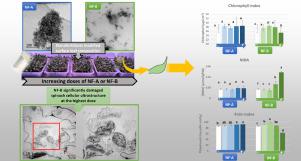Scientia Horticulturae ( IF 3.9 ) Pub Date : 2022-04-20 , DOI: 10.1016/j.scienta.2022.111143 M. Gil-Díaz 1 , P. García-Gonzalo 1 , C. Mancho 1 , L.E. Hernández 2 , J. Alonso 1 , M.C. Lobo 1

|
The use of nanofertilizers could be a potential solution to address the current challenges of agriculture (global hunger, increase of world population, highly inefficient use of fertilizer, soil nutrient deficiency and scarcity of raw materials). Most available literature focuses on the effects of some nanomaterials synthesized at lab scale and detailed information about commercial nanofertilizer is lacking. The aim of the present study was to characterize two commercial nanofertilizers (NF-A and NF-B) and evaluate the effect of their foliar application at increasing doses (recommended dose (RD), 10RD, 100RD and 500RD) on spinach plants. Both nanofertilizers differed greatly in composition, colloidal stability and morphology. Their impact on spinach leaves depended on nanofertilizer composition and dose and they did not have negative effects at the recommended dose or at 10RD. However, NF-B at the highest doses (100RD and 500RD) had major negative effects on leaves compared to NF-A and induced a reduction in the content of chlorophyll, polyphenols, flavonols and antioxidant activity, an increase in oxidative damage, and the deterioration of the cellular ultrastructure according to TEM analysis. In contrast, leaves treated with NF-A showed few changes and only at the highest dose (500RD) were some adverse effects detected. Foliar application of the two commercial nanofertilizers modified the surface composition as well as the nutrient content of the leaves, adding new elements and increasing the content of others, especially at the highest doses tested. The present study will contribute to the establishment of safe levels of nanofertilizer exposure and provides a starting point for studies on the mechanisms involved in nanoparticle uptake by leaves.
中文翻译:

菠菜植物对两种商业纳米肥料不同剂量的反应
使用纳米肥料可能是解决当前农业挑战(全球饥饿、世界人口增加、肥料使用效率极低、土壤养分缺乏和原材料稀缺)的潜在解决方案。大多数现有文献都集中在实验室规模合成的一些纳米材料的影响上,缺乏关于商业纳米肥料的详细信息。本研究的目的是描述两种商业纳米肥料(NF-A 和 NF-B)的特征,并评估其叶面施用增加剂量(推荐剂量 (RD)、10RD、100RD 和 500RD)对菠菜植物的影响。两种纳米肥料在成分、胶体稳定性和形态方面差异很大。它们对菠菜叶的影响取决于纳米肥料的成分和剂量,在推荐剂量或 10RD 时它们没有负面影响。然而,与 NF-A 相比,最高剂量(100RD 和 500RD)的 NF-B 对叶片产生重大负面影响,并导致叶绿素、多酚、黄酮醇和抗氧化活性的含量降低,氧化损伤增加,根据 TEM 分析,细胞超微结构的恶化。相比之下,用 NF-A 处理的叶子几乎没有变化,只有在最高剂量 (500RD) 时才检测到一些不利影响。两种商业纳米肥料的叶面施用改变了叶子的表面成分和养分含量,添加了新元素并增加了其他元素的含量,尤其是在测试的最高剂量下。







































 京公网安备 11010802027423号
京公网安备 11010802027423号